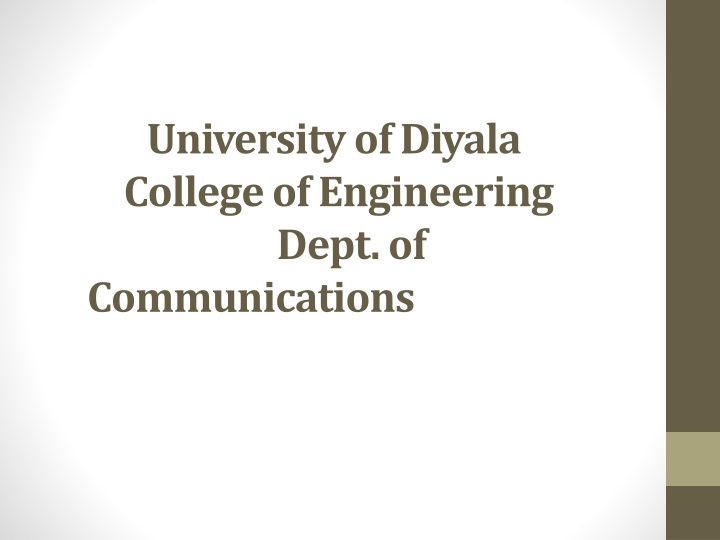
Advantages of Digital Communications: Regeneration, Noise Immunity, and Reliability
Explore the benefits of digital communications, from easy signal regeneration to immunity against noise interference and enhanced reliability. Understand why digital signals are preferred over analog, highlighting the efficiency in error detection and correction, low production costs, and widespread utilization in modern computer-based communication systems.
Download Presentation

Please find below an Image/Link to download the presentation.
The content on the website is provided AS IS for your information and personal use only. It may not be sold, licensed, or shared on other websites without obtaining consent from the author. If you encounter any issues during the download, it is possible that the publisher has removed the file from their server.
You are allowed to download the files provided on this website for personal or commercial use, subject to the condition that they are used lawfully. All files are the property of their respective owners.
The content on the website is provided AS IS for your information and personal use only. It may not be sold, licensed, or shared on other websites without obtaining consent from the author.
E N D
Presentation Transcript
University of Diyala College of Engineering Dept. of Communications
Digital Communications By HaidarN. Al-Anbagi Lec(1) Time: (4 hrs) Date: Sep. 3rd, 2017
Introduction to digital communications: In this lecture, we present and discuss the principles of digital communications. Digital communication systems involve the transmission of data in a digital form. The data is generated by a source of information. After we get the data represented in a digital form, the digital communication system sends this digital data through channels to one or multiple destinations. These channels have direct impact on the transmitted data; therefore, we will discuss some types of the communication channels in this lecture as well.
Why digital? We can notice that all communication systems are going digital but the question is why? The main advantage of digital signals is the ease of regeneration. If we compare digital and analog signals, it is much easier to regenerate corrupted digital signal as it is shown in figure 1. Figure 1 illustrates how a digital signal gets distorted over distance. The further the propagation distance, the more distortion the signal will get. Therefore, the transmitted digital signal has to be regenerated after a certain distance and that regeneration is done using digital amplifier.
Question: What is the reason that digital signals are easy to regenerate? Answer: When a digital signal gets distorted, it is still easy to identify whether the signal is 1 or 0. For example, in figure 1, it is obvious that the digital signal is badly distorted at distance 4, however, we can easily say it is 1. Figure (1) Digital signal degradation and regeneration
In addition to the ease of regeneration, digital signals are less vulnerable to get affected by noise because digital circuits operate in one state at a time. They could be either fully-on or fully-off. Therefore, it is difficult to change the circuit state from one to the other one unless the source of disturbance is large enough. On the other hand, analog signals are not two state signals; they can take an infinitive variety of shapes and that causes the problem of making the regeneration is very difficult. Once the analog signal gets corrupted, it is very difficult to do regeneration.
Moreover, with the efficient error detection correction techniques, extremely low error rates will be contained in the received signal and that adds the third advantage to digital communications over analog communications. The fourth advantage of digital communications is the reliability and the low cost of production. Digital circuits can be produced in a lower cost compared to analog circuits. Finally, nowadays almost all signals are transmitted from computers to computers or to digital instruments and these signals are digital so the best way to transmit digital signals are digital communication systems. The only disadvantage of digital communication is the degradation. When a digital signal degrades below a certain threshold, the quality drops significantly, while analog signals degrade more gracefully.
What is the meaning of analog, discrete, and digital signals? Analog: The analog signal has a value at any time as it is shown below, Discrete: The discrete signal has a value at certain n values as it is shown below, Digital: The digital signal has a certain value at certain time n values as it is shown below,
Elements of digital communication system: Figure 2 shows a typical digital modulation system. The data generated by the source of information could be either analog such as speech and video, or it could be digital such as computer signal. In a digital communication system, the date generated by the source of information has to be represented by a sequence of binary digits. In this binary representation, we should use as less bits as we can for the purpose of efficiency. Therefore, the lesser the bits in the binary representation, the better the efficiency of the representation will be. The other aspect we seek for in our representation is related to redundancy. The binary representation should have little or no redundancy. The process of process of converting the data generated by the source of information into binary bits is called source coding or data compression.
